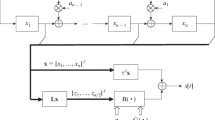Abstract
The digital multistep method generates uniform pseudorandom numbers by transforming sequences of integers obtained by multistep recursions. The statistical independence properties of these pseudorandom numbers depend on the characteristic polynomial of the recursion. We describe a method of calculating characteristic polynomials that are optimal with respect to statistical independence of pairs of successive pseudorandom numbers. Tables of such optimal characteristic polynomials for degrees ≤64 are included.
Zusammenfassung
Die digitale Mehrschrittmethode erzeugt gleichverteilte Pseudozufallszahlen durch Transformation von Folgen ganzer Zahlen, die aus Rekursionen höherer Ordnung gewonnen werden. Die statistischen Unabhängigkeitseigenschaften dieser Pseudozufallszahlen hängen vom charakteristischen Polynom der Rekursion ab. Es wird eine Methode zur Berechnung von charakteristischen Polynomen beschrieben, welche bezüglich der statistischen Unabhängigkeit von Paaren aufeinanderfolgender Pseudozufallszahlen optimal sind. Die Arbeit enthält auch Tabellen solcher optimaler charakteristischer Polynome für Grade ≤64.
Similar content being viewed by others
Explore related subjects
Discover the latest articles, news and stories from top researchers in related subjects.References
Beard, J. T. B., Jr., West, K. I.: Prime and primitive polynomials of degreen overGF(p d), unpublished table, edited from exhaustive factorization tables obtained by computer.
Brillhart, J., Lehmer, D. H., Selfridge, J. L., Tuckerman, B., Wagstaff, S. S.: Factorizations ofb n±1,b=2, 3, 5, 6, 7, 10, 11, 12 up to High Powers. Contemporary Mathematics, Vol. 22. Providence: Amer. Math. Soc. 1983.
Knuth, D. E.: The Art of Computer Programming, Vol. 2: Seminumerical Algorithms, 2nd ed. Reading: Addison-Wesley 1981.
Lidl, R., Niederreiter, H.: Introduction to Finite Fields and Their Applications. Cambridge: Cambridge Univ. Press 1986.
Marsaglia, G.: Random numbers fall mainly in the planes. Proc. Nat. Acad. Sci. U. S. A.61, 25–28 (1968).
Niederreiter, H.: The performance ofk-step pseudorandom number generators under the uniformity test. SIAM J. Sci. Statist. Computing5, 798–810 (1984).
Niederreiter, H.: Pseudozufallszahlen und die Theorie der Gleichverteilung. Sitzungsber. Österr. Akad. Wiss. Math.-Naturwiss. Kl.195, 109–138 (1986).
Niederreiter, H.: The serial test for digitalk-step pseudorandom numbers. Math. J. Okayama Univ. (to appear).
Niederreiter, H.: Rational functions with partial quotients of small degree in their continued fraction expansion. Monatsh. Math.103, 269–288 (1987).
Niederreiter, H.: Point sets and sequences with small discrepancy. Monatsh. Math. (to appear).
Peterson, W. W., Weldon, E. J., Jr.: Error-Correcting Codes, 2nd ed. Cambridge: M.I.T. Press 1972.
Tausworthe, R. C.: Random numbers generated by linear recurrence modulo two. Math. Comp.19, 201–209 (1965).
van Wijngaarden, A.: Mathematics and computing. Proc. Symp. on Automatic Digital Computation, pp. 125–129. London: H. M. Stationery Office 1954.
Author information
Authors and Affiliations
Rights and permissions
About this article
Cite this article
Mullen, G.L., Niederreiter, H. Optimal characteristic polynomials for digital multistep pseudorandom numbers. Computing 39, 155–163 (1987). https://doi.org/10.1007/BF02310104
Received:
Issue Date:
DOI: https://doi.org/10.1007/BF02310104




